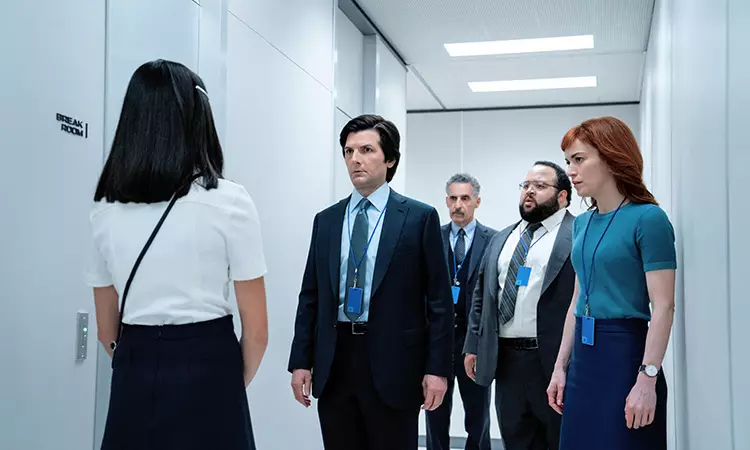In a modern context where workplace dissatisfaction is commonplace, Dan Erickson, the visionary behind Apple TV+’s “Severance,” found inspiration in an all-too-common sentiment: the desire to escape the tedium of a mundane job. Reflecting on his own experience, Erickson recalls wishing he could fast-forward through the hours of work to emerge at 5 PM, free from the constraints of his job. This realization sparked the inception of “Severance,” a show that delves into the complex relationship between work and personal identity. The series explores an unsettling premise: employees undergo a procedure that permanently separates their work memories from their personal experiences. This bizarre exploration strikes at the core of contemporary existential quandaries, prompting viewers to ponder the implications of such a disconnection from oneself.
At the heart of “Severance” is Mark Scout, played by Adam Scott, who navigates the mysterious corridors of Lumon Industries. However, the narrative extends beyond Mark to include his equally estranged colleagues: Helly, Irving, and Dylan. Their journey throughout the first season introduced viewers to the fundamental question of identity. As they fight against the confines of their severed existence, the show probes an underlying question: Who are they when stripped of their workplace personas? The culmination of Season One leaves us yearning for answers about their lives beyond Lumon’s sterile walls, suggesting a broader exploration in the upcoming season.
Erickson meticulously crafted these characters’ backstories, providing them with depth that starkly contrasts with their odd realities within Lumon. As he works with his team, including Ben Stiller and Beau Willimon, he ensures that their backstories remain intact, while hinting that viewers will learn more about them as the narrative unfolds. This deliberate character development heightens the intrigue, compelling audiences to reevaluate their initial perceptions of each character in light of their motivations for undergoing such a drastic mental alteration.
As the second season approaches, Erickson faces the daunting task of expanding the narrative world established in Season One. He recognizes the dual challenge of elaborating the company’s mysteries while simultaneously deepening character explorations. In the first season, Lumon Industries was shrouded in ambiguity, functioning almost as a character in its own right. The company’s true purpose remains elusive—managing to flirt between a corporate entity and a cult-like organization. Viewers are left to wonder about its machinations, adding to the show’s gripping tension.
Erickson promises that Season Two will delve deeper into Lumon’s operations, unraveling some of the show’s most pressing questions while maintaining the layers of mystery that have fueled fan speculation and theories online. He believes that revealing answers organically, while introducing new dilemmas, ensures that the narrative remains engaging and cohesive. Thus, “Severance” evolves not merely as a story but also as a dialogue between creators and the audience.
As the series gains traction, it cultivates an enthusiastic fanbase, with theories proliferating across social media and fan forums. Erickson shares a love-hate relationship with these theories, understanding the significance of audience engagement while acknowledging the potential pitfalls of overexposure. While he appreciates the creative endeavors of fans—demonstrated through captivating fan art—there lies a tension in balancing external influences with his artistic vision for the show. This interplay between creator intent and fan interpretation enriches the viewing experience, allowing for a communal exploration of the series’ dense themes.
Ultimately, “Severance” asks profound questions about identity, self-awareness, and the human experience. What drives someone to sever ties with their own past? What does it mean to disconnect in a world where work often defines identity? The characters’ experiences echo deeper societal issues, including work-life balance and the risks of losing oneself amid grueling corporate structures. This existential dilemma is poignantly highlighted through the emotional arcs of each character, making their journeys relatable and terrifyingly reflective of contemporary life.
Erickson’s willingness to divulge snippets of information while holding back the larger narrative arc reflects an understanding of pacing that keeps audiences invested. Each episode is a window into a broader philosophical canvas, right down to the enigmatic presence of goats, which have sparked countless debates among viewers. As the series progresses, the layered storytelling promises to address these mysteries while delving into the characters’ haunted identities.
The Road Ahead
As “Severance” prepares to return, viewers stand on the verge of uncovering the deeper dilemmas of the Lumon universe. Erickson appears poised to anchor the narrative on profound human questions, exploring the complexities of work, identity, and the allure of disassociation. With a vision that transcends mere entertainment, “Severance” dares to dissect the human psyche in a corporate world increasingly marred by disconnection. The tension between curiosity and fear regarding the unknown is a fitting analogy for both the show’s storyline and our collective experience in the ever-evolving landscape of modern work and identity.

